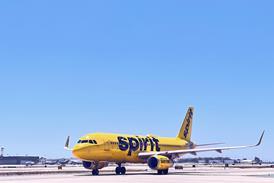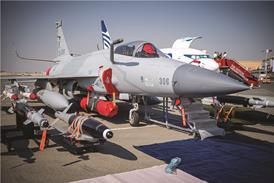Julian Moxon/ANKARA
Turkish Aerospace Industries (TAI) has expanded its portfolio dramatically in recent years as part of a new strategy aimed at broadening its capabilities. It is a long way from the single product co-producer of F-16s founded in 1984. "We've more work than we can cope with," says Aydin Oniz, executive director of business development and management.
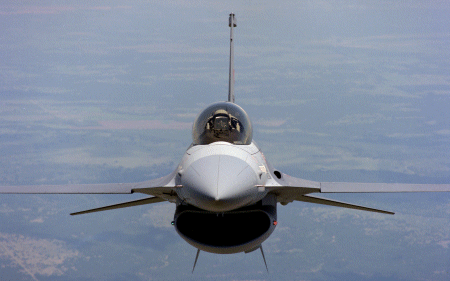
The official 10-year strategic plan for the company is "to develop an industrial capability which enables it to support Turkish military requirements and to participate in international commercial programmes". The strategy seems to be paying off as TAI capitalises both on indigenously sourced and offset work to develop capabilities which run across the board of aeronautical expertise.
Four distinct elements form the impetus for development of Turkey's aerospace industry, says TAI general manager Kaya Ergenc: "First and foremost, we have to satisfy the operating requirements of the user - the Turkish armed forces. Next is the economic consideration - we have to think about price and offsets to ensure we are able to get the best value for money on any particular contract. Then there is the political dimension, which takes account of Turkey's sought membership of the European Union, and also of the fact that there is a US embargo on direct arms sales. Finally, technology transfer is an essential element for building up the capabilities of our industry."
At the height of the Peace Onyx F-16 co-production programme, TAI's workforce stood at 2,400. Peace Onyx saw 232 aircraft built for the Turkish air force and a further 46 for Egypt. The final aircraft was delivered last November, marking the end of an era which began when the agreement to co-produce the aircraft was signed with General Dynamics (now Lockheed Martin and a 42% shareholder in TAI ).
"Now, we employ 1,930 and we want to keep it stable at that level - otherwise it can be difficult when there is less work around," says Oniz. "We generate profit and we have re-invested that to keep us up the mark in the most advanced technologies." He points to the new $30 million composites facility that was completed in the early 1990s, since when a further $10 million has been invested to bring in new technologies. "This has bought TAI work it would not otherwise have had," he adds.
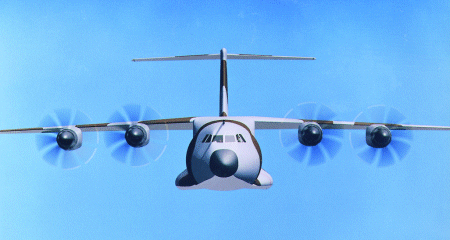
The company's development will receive a huge boost from two major military programmes that, when they have entered service, will give Turkey a military capability equal to any of its NATO partners. The first is the Airbus Military Company's (AMC) A400M transport, in which TAI has formed its first ever risk-sharing partnership. This is now certain to go forward following the approval of development funding from all of the seven international participants. The second, the ATAK attack/tactical reconnaissance helicopter programme, will bring the company its first prime contractorship. This finally took off on 21 July with the decision in favour of the Bell King Cobra.
Partnership in AMC
TAI has taken a 9% partnership in AMC following Turkey's commitment to purchase 26 aircraft. "This is a very good programme for us," says Oniz. "because it will really help us to develop our own capabilities through being involved in design and production." He adds that TAI can never be run entirely on a commercial basis "because of our commitment to the armed forces". About 25% of business comes through commercial contracts, but the intention is to increase this to 40%-50%in 10 years "so that we don't have to rely entirely on military business".
Negotiations on the licensed manufacture of 145 Bell AH-1Z King Cobras began in September following the decision to give "first priority" to the US aircraft. Talks centre on a $1.5 billion initial agreement on the technology transfer and production of the first 50 machines, along with associated pricing and technical issues. Over the next 10 years, the ATAK programme is expected to generate jobs for 3,000 people in Turkey through the offset deal. "It is," says TAI, "the most intensive defence industry project we have ever undertaken in terms of industrialisation and technology transfer."
TAI is also negotiating with Turkish avionics manufacturer ASELSAN on development of the King Cobra target identification system, integrated navigation system, multifunctional displays, control and display unit, and VHF radio. It is working with NETAS on an identification friend-or-foe system, and with engine manufacturers TEI and General Electric on the T700-701C engine offset agreement.
The Bell deal is not yet guaranteed - so the defence ministry is keeping talks going with the other competition finalist, Israel Aircraft Industries/Kamov, which proposed the Erdogan derivative of the co-axial rotored Ka-50. The final contract is due to be signed in the first quarter of 2001. Production will begin in 2002.
Depending on the outcome of negotiations with the US Government, the ATAK programme is also expected to give Turkey an opportunity to carry out its first ever serious military export activity, to what is described as a "limited number of potential customers in nearby countries".
In terms of business, TAI is expanding fast. Average annual sales are around $80 million, and expected to grow to $120 million in 2001. Last year saw 12 contracts worth a total of $134 million being signed with eight customers, including Boeing, Sikorsky and MD Helicopters, and the figure for this year is expected to be "significantly higher", says Oniz. This year also saw TAI finishing up with the second highest cash reserves in its history.
"We're looking at a record work volume by 2001 with a correspondingly high financial yield," says Ergenc, although he points to the immense task of adjusting from what was essentially a single-product company to one with a wide civil and military range. He cautions against going forward too fast, however: "I believe we should be able to design and build our own products, but I'm talking a technology level more appropriate to drones than the Space Shuttle." TAI's target drone programme, which was signed last December, covers the supply of five vehicles to the Turkish Land Forces and a further 10 to the air force. "It's a simple programme: it teaches us to manage disciplines and processes, and it gives us a stand-alone capability that is highly relevant to other programmes".
Another standalone programme is for the Ziu agricultural aircraft. Started in 1997, this is TAI's first indigenous manned aircraft programme, and was initially aimed partly at a Turkish requirement for agricultural aircraft to operate as part of its Southeast Anatolian Project. Bangladesh, Egypt, Indonesia, Iran, Malaysia, Nigeria and Pakistan are "monitoring" the programme as potential customers.
Design leadership
TAI has design leadership of the Ziu and, although suffering initial delays caused by supplier problems, says test flights, which began on 26 June, are now "on schedule". Eight flights have been carried out.
A decision on a second prototype "will be taken after market research activities are finalised. If research shows there is enough demand, certification of the first prototype will be accelerated and a second will be produced."
The Ziu, powered by a 450kW (600hp) Orenda OE600 eight-cylinder turbocharged piston engine, is funded by TAI, the Turkish ministry of industry and trade and the scientific and technical research council. Maximum take-off weight is 3.5t. The fuselage and wings are of metal construction. The 1,500litre (570USgal) hopper, wing-tips and removeable side-panels are made from TAI-manufactured composite materials.
In April last year, TAI signed a memorandum of understanding with MD Helicopters for sole source manufacture of MD902 fuselages, previously built in Australia by Hawker de Havilland. The first fuselage was delivered to MD Helicopters the following October and the 15th has now been handed over. "We're paying a lot of attention to this programme," says Ergenc, "and are in the process of proposing the manufacture of other elements as well." He reveals that TAI was offered the entire programme, "but we thought that because of the risk and capital investment, it was unlikely to receive board approval".
The all-composite MD902 bought TAI further experience in using the material on top of that acquired in an earlier programme to manufacture composite nose and tail components for the EADS (CASA)CN235 light transport aircraft. As with many other programmes, the driving force came out of an offset agreement with former MD Helicopters owner, Boeing, as part of a deal involving 737s for Turkish Airlines (THY).
The relationship with CASA, formed through their co-production of 50 CN235s for the air force between 1991-8, was further strengthened with a sub-contract to manufacture 18 fuselage panels for Airbus A319/A320/A321s as part of an offset agreement forged with Airbus when THY bought A340s. A further six CN235 anti-submarine warfare aircraft for the navy and three marine patrol aircraft for the coast guard are being produced.
Boeing also figures in TAI's commercial aircraft line-up and became an official sub-contractor in February last year. It is manufacturing 600 wing-tips and 400 flight deck panels for various 737 models. This work has bought TAI vital expertise in lean manufacturing techniques: "They're helping us a great deal," Oniz says . He quickly adds, however, that the Boeing work "is not because they like us - but because it is in their best interests".
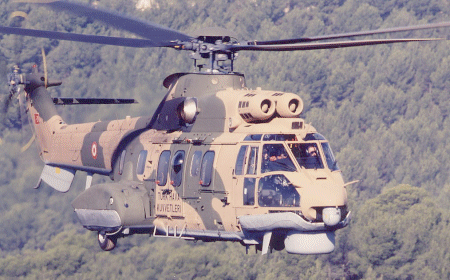
TAI also manufactures engine cowlings and rear doors for the twin-engined EC135 and was authorised in February by the helicopter's manufacturer, Eurocopter Deutschland, to supply 120 of the 700 shipsets stipulated in the contract. A more significant programme covers the 1997 deal for licensed manufacture of Eurocopter AS532UL Cougar Mk 1s for the Turkish armed forces. This includes 30 machines, worth $450 million, to follow the 20 already ordered from Eurocopter for the Turkish land forces under an earlier contract signed in 1993.
The first TAI-built Cougar was handed over in May, kicking off a production effort that will see another 10 Cougars delivered to the land forces and a further 20 combat search and rescue machines to the Turkish air force. Delivery of the first six aircraft will take place at a rate of one per month, with completion set for February 2003. Under the PHENIX 2 agreement on the Cougar, TAI and Eurocopter formed the EUROTAI consortium in 1997, with TAI responsible for manufacturing and building the airframe, assembling the helicopters and performing acceptance testing. The consortium provided the basis for the two-year technology transfer effort, under which TAI provided tooling and built up the necessary systems integration experience.
Yet another programme, this time carried out entirely in-house, was the modernisation and conversion of 15 redundant ex-navy S-2E Tracker maritime patrol aircraft for firefighting duties. It involved installing into each a water tank with a 4.5t capacity, exchanging the piston engines for Honeywell (ex-AlliedSignal) TPE-331-14GR turboprops and installing new avionics. Begun in February 1998, the first aircraft was handed over to the ministry of forestry in August last year for trials based at Antalya. The aircraft saw action on its first day, when the crew attended a forest fire at Serik while performing a familiarisation flight. "They accomplished the mission," says TAI. It subsequently carried out 38 sorties attending the refinery fire at Tupras following the country's disastrous earthquake on 17 August.
Unmanned air vehicles
TAI has also got into the unmanned air vehicle (UAV) business owing to the government requirement for short-range and long-range systems for the Turkish armed forces. A request for proposals is expected to be issued by the Turkish state procurement agency, the SSM, in the first quarter of 2001, covering an in-house, TAI-developed short-range drone and a technology transfer programme for the long-range vehicle. TAI ASELSAN plans to form a team to work on one of three proposals being submitted by foreign companies (IAI, Elbit and Silver Arrow, and Catic).
On top of its many commitments, TAI has become a "major participant" in the US Joint Strike Fighter programme. The signature, due in March, means that Turkey will almost certainly not become a partner in a European fighter programme to replace its F-16s in 2015-2020. On the other hand, it would mean another step, in industrial terms, towards ensuring its foothold in the most advanced technology developments now taking place.
Source: Flight International


